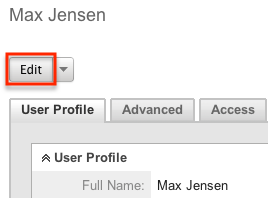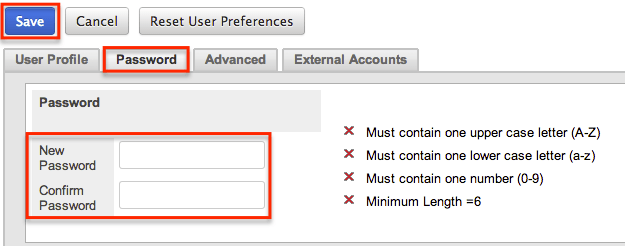User Management
Overview
The User Management module provides administrators access to create, edit, activate, and deactivate the profiles of all the users in their Sugar instance. This module and underlying settings control each individual's login credentials as well as some personalized settings. During the installation process, Sugar creates one system administrator by default. The system administrator can log in and create additional users, in a variety of capacities, to be able to access Sugar and utilize all of the other CRM functionality. In combination with the role and team security, administrators can fully establish a profile for each user in Sugar.
User Types
There are four types of users in Sugar: Regular User, System Administrator, Group User, and Portal API User. Each user type has different functions in Sugar which will vary for each instance. Depending on an organization's use of Sugar, not all of these user types will be necessary. Only regular users and system administrators in an Active status count towards licensed user limits. The purpose of each user type is explained in the following sections.
Regular User
A regular user is the most common of the user types. A majority of employees of an organization will be regular users. This user can access most Sugar modules and perform most standard functions by default. Regular users are subject to be restricted in their abilities and what records they can access by an administrator using the Teams and Roles functionalities in Sugar.
Regular Users will appear in the Employees module. To create a Regular User, please review the Regular and Admin Users section of this page.
System Administrator
System Administrator users, or "admins," have all of the abilities and functionality of a regular user, but also have administrative privileges as well. Admins can perform functions such as creating and editing users, editing system-wide settings, and have access to diagnostic and troubleshooting tools. In addition, admins can access all modules and records and are not subject to team or role restrictions. All instances of Sugar require at least one administrator, but it is also recommended to have more than one in case the original admin is unavailable or is no longer with the company.
System Administrators will appear in the Employees module. To create a System Administrator, please review the Regular and Admin Users section of this page.
Note: All administrators where the user status is active count as a licensed user.
Group User
A Group User is a bucket that is used for assigning records to a non-specific user (e.g., Sales, Support) in the organization. Unlike a Regular or System Administrator user, a Group user does not have access to log in to Sugar. Due to this, they do not have the same profile settings available, including the option to set a password. Since Group users cannot log in to Sugar, they do not count against an organization's license count.
Examples of uses for a Group user would be to assign all new leads to a group user named "Sales" or assign all newly-created support cases to "Support" before they are delegated to specific users (e.g., John Smith) in the organization.
Please note that Group users will not appear in the Employees module. For more information on how to create a Group user, please review the Group Users section of this page.
Portal API User
A Portal API User is similar to a Group User except that it is created specifically to communicate with the Sugar server using the Sugar Portal API functionality. It is intended only for use with Sugar Portal; the user with user name "SugarCustomerSupportPortalUser" is automatically enabled when the Sugar Portal is enabled via Admin > Sugar Portal. It must remain enabled in order for portal users to authenticate. This user can only be used to authenticate contact credentials against portal API methods and determine portal account permissions based on the Customer Self-Service Portal role. To create a Portal API user, please review the Portal API Users section of this page.
Portal API Users will not appear in the Employees module and are not counted in the user license agreement. More information about the Sugar Portal can be found in the Sugar Portal documentation. Sugar's API documentation can be found in the Web Services section of the Developer Guide.
Note: The Portal API user is not intended to be a free API user for external integrations and has very limited functionality through the API.
License Types
Users are given access to specific capabilities in the product by assigning them one or more licenses (e.g., Sugar Sell Premier, Sugar Serve) in the License Type field on the user record. See the License Management page for details on working with user licenses and license limits.
To compare which functionality each license type has access to, refer to the License Types Matrix page.
User Fields
The Users module contains a number of stock fields, which are included out-of-the-box with Sugar. The below definitions are suggested meanings for the fields, but many of the fields can be leveraged differently to best meet your organization's needs. System Administrators have the ability to alter, remove, or add fields in the User Profile tab via Admin > Studio, minus a few noted exceptions. For more information on adding or modifying fields, please refer to the Studio documentation.
For instances that use SugarIdentity, the following user fields are read-only and can only be edited in SugarIdentity:
- Username
- Status
- User Type
- First Name
- Last Name
- License Type
Note: For certain SugarIdentity-enabled instances, this field is only available to manage in SugarIdentity. - Title
- Department
- Work Phone
- Address Street
- Address City
- Address State
- Address Postal Code
- Address Country
- Primary Email Address
The User Profile tab contains the contact information for the user and other important user-specific settings. The User fields are as follows:
| Field | Description |
| Address City | The city of the user's address. |
| Address Country | The country of the user's address. |
| Address Postal Code | The postal code of the user's address. |
| Address State | The state of the user's address. |
| Address Street | The street name and number of the user's address. |
| Avatar | Upload an image to this field to represent the user that will be shown on the Activity Stream and next to the user's name on the navigation bar. |
| Business Center Name | The business center this user belongs to. |
| Department | The department where this user works. |
| Description | A description or other information about this user. |
| Display Employee Record | Check this box if the user should have an employee record show in the Employees module. |
| Email Address | The user's email addresses, where a primary address is selected to receive email notifications and if this should be a reply to address when using Sugar's outbound email (SMTP) functionality. Note: This field is not editable in Studio. |
| Email Client | When clicking on an email address in Sugar, this will determine if Sugar's email composer will open or if the user's primary email program on this computer (e.g., Microsoft Outlook, Apple Mail, etc.) will open. Note: This field is not editable in Studio. |
| Employee Status | The user's employment status in the organization (Active, Terminated, or Leave of Absence). Note: The Employee Status and Status fields are managed separately, so consider choosing a new employee status when the Status field changes. |
| Fax | The user's fax number. |
| First Name | The user's first name. |
| Home Phone | The user's home phone number. |
| IM Name | The user's instant message screen name. |
| IM Type | The user's instant message service type. |
| Last Name | The user's last name. |
| License Type | Determines what Sugar functionality the user may access. For more information, refer to the License Types section above. Note: For certain SugarIdentity-enabled instances, the License Type field is managed in SugarIdentity. |
| Mobile | The user's mobile phone number. |
| Other Phone | An additional phone number for the user. |
| Reports to | The user's manager. The user that this user reports to will become an implicit member of this user's Teams. The "Reports To" field is also leveraged by several features in Sugar. For more information, refer to the Understanding the Reports To Field section of this page. Note: This field is not editable in Studio. |
| SMTP Password | If an outgoing email server is defined in Admin > System Email Settings, the user's SMTP password can be input here to send mail through Sugar. Note: This field is not editable in Studio. |
| SMTP Username | If an outgoing email server is defined in Admin > System Email Settings, the user's SMTP user name can be input here to send mail through Sugar. Note: This field is not editable in Studio. |
| Status | Making a user inactive will make it so this user cannot log in to Sugar. This will also remove the user from taking a license seat, without having to delete the user. When making a user inactive, the admin is prompted to use the Reassign Records function. Note: The Employee Status and Status fields are managed separately, so consider choosing a new employee status when the Status field changes. |
| Title | The user's job title. |
| User Name | The user name will be what the user logs in to Sugar with on the login page. It will also show for other users when they view fields such as "Assigned to" and "Created By". This is the name that will define the specific user in Sugar and should be unique for every user. |
| User Type | Specifies what type of user this is which, a system administrator, regular user, etc as described in the User Types section above. Note: This field is not editable in Studio. |
| Work Phone | The user's work phone number. |
The Advanced tab in the user's profile includes settings to configure how Sugar will function for that specific user. The fields in the Advanced tab cannot be edited in Studio.
| Field | Description |
| 1000s Separator | Select a character to use as a 1000's separator, with an example showing in the "Example" box. |
| Create Revenue Line Items in Preferred Currency | Mark the checkbox to use your preferred currency when creating revenue line items based on a product catalog item, |
| Data Font Size | The default font size of the PDF body when generated by this user. |
| Date Format | How date fields will appear for the user, with the ability to control month, day, and year formatting. |
| Decimal Symbol | Select a character to use as a decimal symbol, with an example showing in the "Example" box. |
| Default Teams | A default team defines the team set when this user creates a record. Whenever this user creates a record, the team is set as the user's default team, similar to how the "Assigned To" field is set to be the created user. Note: Users can be assigned any number of default teams. |
| Export Delimiter | Character or characters used to delimit exported data by this user. |
| Field Name Placement | Choose whether field names are displayed above or beside field values in record view; by default, field names are displayed beside the field value. This option does not apply to the Record View dashlet. |
| First Day of Week | Which day of the week will show as the first day when the user views the Sugar legacy calendar. |
| Font for Footer | Select a font for the footer in PDF documents when generated by this user. |
| Font for Header and Body | Select a font for the header and body of PDF documents when generated by this user. |
| iCal integration URL | URL in which someone can subscribe to the user's Sugar legacy calendar within iCal or other programs that support iCal integrations. |
| Import/Export Character Set | The default character set used for imports, exports, and vCard generation for this user. |
| Main Font Size | The default font size in the PDF header when generated by this user. |
| Name Display Format | How concatenated name fields will appear for the user, with the ability to control first name, last name, and salutation formatting. |
| Notify on Assignment | When this box is checked, the user will receive an email notification when a record is assigned to them by another user. Note: A system outbound mail account must be enabled in Admin > System Email Settings. |
| Preferred Currency | Select the user's default currency to be used when creating new records. Additional currencies can be defined in Admin > Currencies. |
| Publish at my Location | Used to share free/busy information between Sugar legacy calendar and Microsoft Outlook calendar. |
| Publish Key | Alphanumeric code entered by the user to uniquely identify his or her legacy calendar and populate the iCal integration URL, Publish at my location site, and Search Location. |
| Reminders |
This field sets the default reminder settings for calls and meetings created by this user so that when the user creates a call or meeting, the reminder settings will be pre-populated to the configuration defined in this field. Popup: Users that are invited to a call or meeting created by this user to receive a browser popup notification for the call or meeting at a given time interval before the activity. Email all invitees: Invitees invited to a call or meeting created by this user to receive an email notification for the call or meeting at a given time interval before the activity. |
| Search Location | Used to share free/busy information between Sugar legacy calendar and Microsoft Outlook calendar. |
| Select Modules for Navigation Bar | The order of the module navigation bar is defined by the order in the Display Modules column and modules listed in the Hide Modules column will not appear in the bar. |
| Show Full Names | When this box is checked, the user will see users' full names ("John Smith") instead of user names ("jsmith") when using Sugar. |
| Show Preferred Currency | Mark the checkbox to convert the base currency to user-preferred currency in list views and record views. Note: User-preferred currency is not used in the Quotes record view or for quoted line items. For more information, refer to the Quotes and Quoted Line Items documentation in the Application Guide. |
| System Significant Digits | Define how many digits will appear after the decimal point when the user views a currency field, with an example showing in the "Example" box. |
| Time Format | How time fields will appear for the user, with the ability to control hour, minute, and 12 versus 24-hour clock formatting. |
| Time Zone | The user's time zone will be automatically set to match their browser's time zone by default. This field is read-only. |
| User Wizard Prompt | Mark the checkbox to have users go through the New User Wizard upon their first login. |
Note: The Quotes and Revenue Line Items modules are not available for Sugar Serve users. For more information on license types and the functionality available for each type, refer to the License Types section.
Understanding the Reports To Field
The Reports To field on the User record is used by various parts of Sugar to determine who a user's manager (i.e., supervisor) is. Some examples of how Sugar uses this relationship are described below:
- Workflow Management: Alerts and actions in Sugar's Workflows module allow you to send an alert to or assign a record to a user's manager. For example, you may wish to notify a user's manager when that user creates a new high-priority case. Refer to the Workflow Management documentation for more information.
- SugarBPM: Users' managers can be used in activity assignments, email recipients, and evaluations when designing a process definition. For example, you may wish to assign an approval activity to the manager of the owner of a quote before the quote is ready to be sent to the customer. Refer to the Process Definitions documentation for more information.
- Forecasts: Managers aggregate the forecast amounts of their reportees with their own forecast amounts to predict their total team's sales and work towards the team's quota. Refer to the Forecasts documentation for more details on how sales managers use forecasts.
- Teams: Managers are an implicit member of all of their reportees' teams, which gives them access to all of their reportees' records. Refer to the Team Management documentation for more details on implicit and explicit team membership.
- Organization Chart Dashlet: This dashlet visually outlines the hierarchy of Sugar users under the current user according to the Reports To field. The dashlet includes reportees that are one or two levels below them.
Note: Only administrators can edit the Reports To field.
Users Module Tab
Click the Users module tab in the navigation bar, shown after selecting User Management in the Admin page, to access the Users list view. You may also click the three-dots menu in the Users module tab to display the Actions and Recently Viewed menus. The Actions menu allows you to perform important actions within the module. The Recently Viewed menu displays the list of users you last viewed in the module. For more information on records last viewed, please refer to the Viewing Via Recently Viewed section of this page.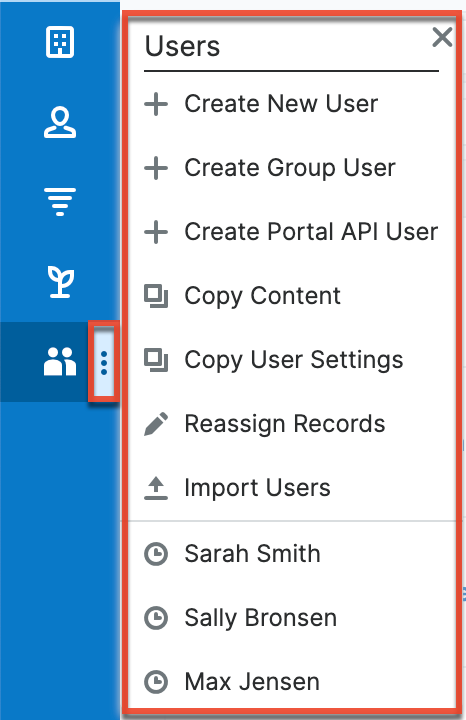
The options in the Actions menu allow you to perform the following types of action:
| Option | Description |
| Create New User | Opens the edit view layout to create a new user. Note: For instances that use SugarIdentity, the SugarIdentity console opens in a new browser tab to create a new user. |
| Create Group User | Opens the edit view layout to create a new Group User. |
| Create Portal API User | Opens the edit view layout to create a new Portal API User. |
| Copy Content | Copy user preferences and content from one user to individual users or all users in a team or role. |
| Copy User Settings | Copy the current user's locale settings to individual users or all users in a team or role. |
| Reassign Records | Opens the Reassign Records tool. |
| Import Users | Opens the import wizard to create or update users using external data. Note: For instances that use SugarIdentity, the import option can only be used to update existing user records. Administrators can access SugarIdentity to import a list of new users using a CSV file. |
Creating Users
There are various methods for creating new users in Sugar. These are via the Users module, duplication, or import. Creating users is an imperative function in Sugar as it allows for other members of your organization to log in and work in Sugar. Please note that you will not be able to add more users of a particular license type than is allowed by your Sugar license. For more information on how Sugar's licensed user limits work, refer to the Understanding User Types, License Types, and Sugar Licenses article.
Creating via Module Tab
The most common method for creating users in Sugar is via the Users module. The edit view layout opens when creating the user directly from the Users menu and includes all of the relevant fields to create a new user. The fields and options on the Create page will vary depending on the type of user you are creating.
Regular and Admin Users
Regular and Admin users are the most common users that will be created in a Sugar instance and contain the most detail and fields compared to the other user types. For more information about the use of Regular and Admin users, please review the Regular User and System Administrator sections of this page.
Use the following steps to create a new user:
- Navigate to Admin > User Management.
- Click the three-dots menu in the Users module tab to open the Actions menu and select "Create New User".
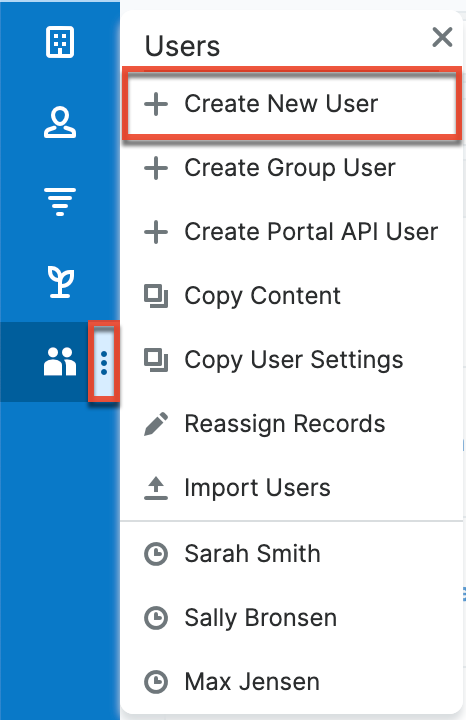
- Enter appropriate values for the fields in the edit view layout. All required fields are marked with a red asterisk and must be completed prior to saving.
- Enter the following information under the User Profile tab:
- In "User Profile" enter a user name for this user which will define the specific user in Sugar and should be unique for every user. Sugar will default the user to being Active and a Regular User, which can be updated if the user is going to be an administrator.
- In "Employee Information", contact information and other specific information about the user can be added. This will include phone numbers, contact address, the user's department and job title, and any description information.
- In "Email Settings" the user's email address or addresses can be added. The email addresses can also be marked as "Primary", meaning that this will be the first email address that shows for the user, and "Reply-to", where automatic notifications from Sugar will be sent. In this section, the user's outbound email client will be selected to default to Sugar or an external program, such as Microsoft Outlook. If a mail server is configured in Admin > System Email Settings, additional options will display here for SMTP Username and SMTP Password.
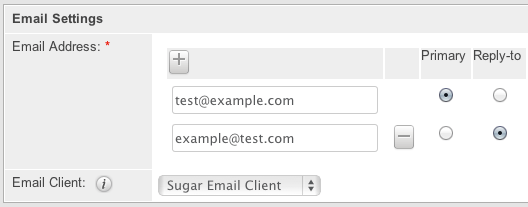
If the administrator has set up an OAuth2-based email account, there will be an Authorize button that will initiate a pop-up to authenticate the email account.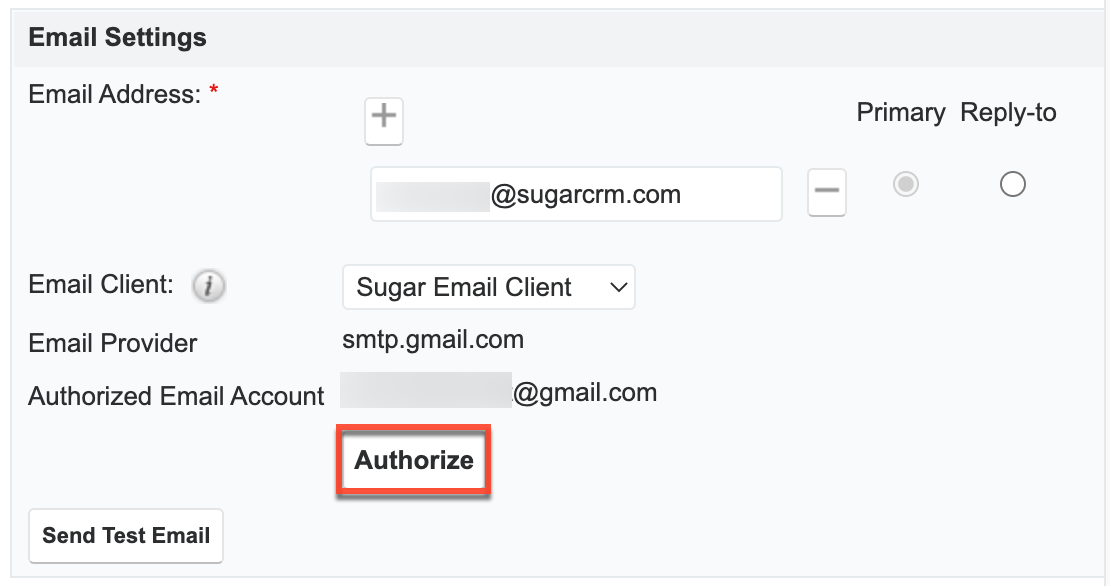
- The Advanced tab includes preference-type settings (User Settings, Layout Options, Locale Settings, PDF Settings, Calendar Options) for the user. These are all specific to the user's account and will not affect system-wide settings or other users. Options such as assignment notifications, date and time formats, time zone, preferred currency, etc. are available to configure under this tab.
- Enter the following information under the User Profile tab:
- A Password tab will appear to the right of the User Profile tab. The administrator can manually enter a password for the user under this tab and provide it to the user. Please note that the password requirements listed on the right will be checked off as the new password meets the required conditions.
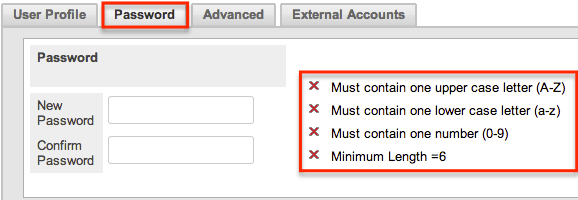
- After entering the necessary information click the Save button.
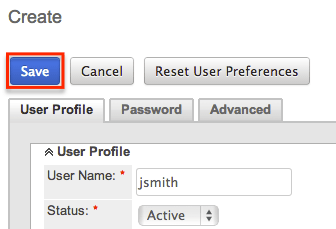
Upon saving, an email will be sent to the user and a corresponding Employee record will be created for the user. Once the user is created, the administrator can assign Teams and Roles to the user via the Access tab.
Group Users
A Group user cannot log in to Sugar, but new and existing records can be assigned to the Group user. The Create page for the Group user consists of the User Name, Status, Name, User Type, and Email Address fields. For more information on how to use Group users in Sugar, please review the Group User section of this page.
Use the following steps to create a Group user:
- Click the three-dots menu in the Users module tab to open the Actions menu and select "Create Group User".
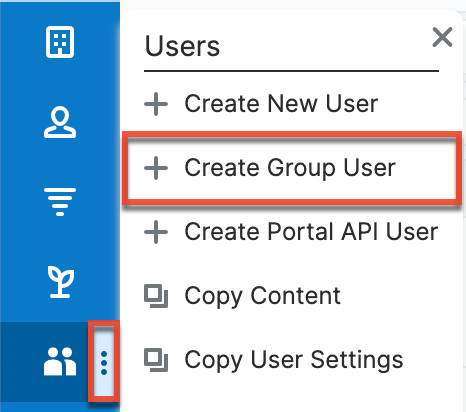
- Enter a name and user name (e.g., Support) for this user.
- In the Email Settings section, enter an email address or addresses for the Group user. The group user's primary email address will be marked as "Primary" and you can also mark "Reply-to" if any automatic notifications from Sugar will be sent to this address.
- Note: If your organization has a group inbox or alias for a team represented by the group inbox, the email address can be added here for all notifications to be sent to the entire team.
- Click "Save" to create the user.
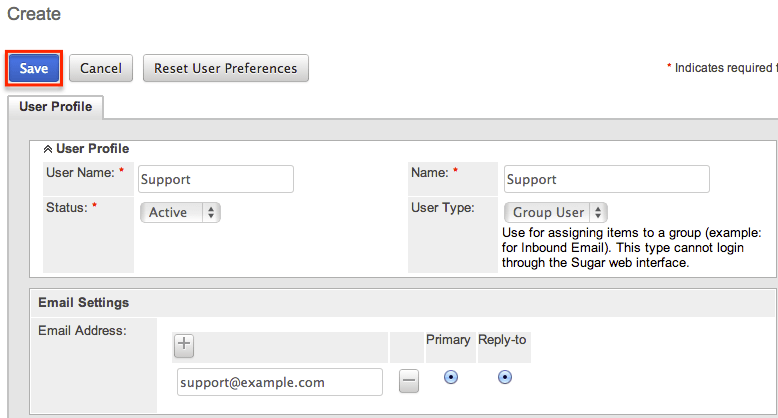
Portal API Users
A Portal API user cannot log into Sugar via the web interface, but the name and user name will appear for other users as they view records assigned to the group user or assign records to this user. The Portal API user creation screen only contains five fields. For more information on the use of the Portal API user, please review the Portal API User section of this page.
Use the following steps to create a Portal API user:
- Click the three-dots menu in the Users module tab to open the Actions menu and select "Create Portal API User".
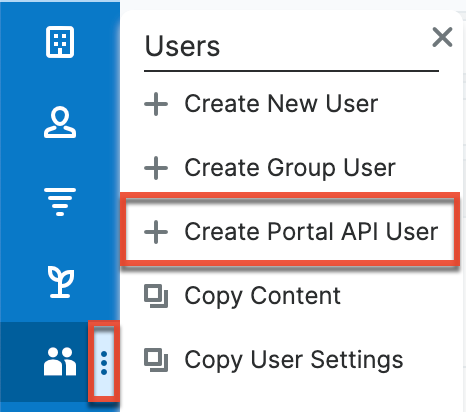
- Enter a name and user name for the user.
- In the Email Settings section, enter an email address or addresses for the API user. The group user's primary email address will be marked as "Primary" and you can also mark "Reply-to" if any automatic notifications from Sugar will be sent to this address.
- On the Password tab, enter and confirm a password for the user following the password requirements set in Admin > Password Management. This password will be used to log in to the API for this user.
- Click "Save" to create the user.
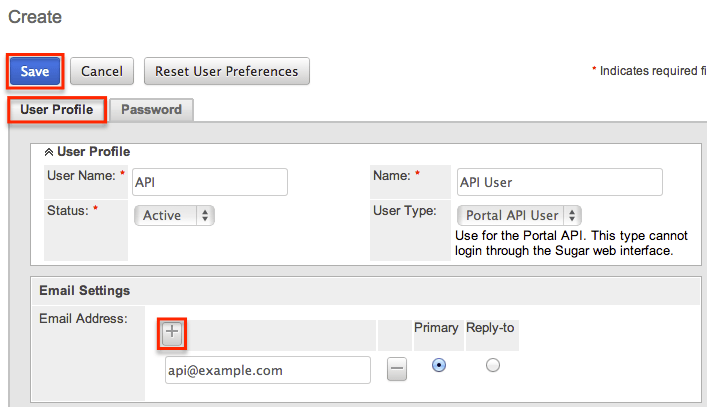
Creating via Duplication
Often, administrators will find themselves in situations where multiple users must be created at once, whether it be when they are first setting up Sugar, a new group of employees is going to be using Sugar, etc. For situations such as these, one user can be configured and additional users can be quickly set up using the Copy option available on the record's detail view. When duplicating a user, all fields are populated from the original record to the duplicated one, except for the User Name field and password fields.
Note: The Copy option is not available for instances that use SugarIdentity.
Use the following steps to create a user by duplicating an existing user:
- Navigate to the detail view of the user you would like to duplicate.
- Click the Actions menu and select "Copy".
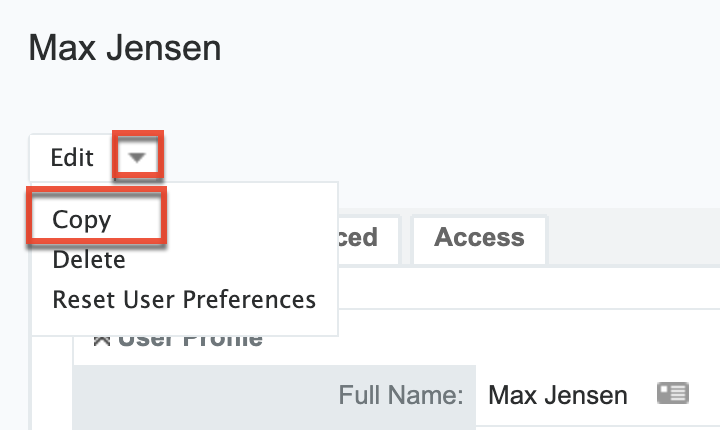
- The displayed edit view is pre-populated with the original user's values, except for the user name and password.
- Populate the "User Name" for the new user and edit any other fields or preferences to be specific to the new user. Fill in any information for the new user that did not exist on the original user.
- A Password tab will appear to the right of the User Profile tab where administrators can manually create a password for the user. Please note that the password requirements listed on the right will be checked off as the new password meets the required conditions.
Note: For instances that use SugarIdentity, administrators will not be able to manually change or reset the user's password via the user's profile. Users can instead click the "Forgot Password?" link on the Sugar login screen to reset their passwords.
- Click "Save".
The new user is now created and available for use. This process is applicable to all user types.
Creating via Import
The import function in Sugar allows you to push multiple user records into Sugar using a comma (or another character) delimited file instead of creating them one-by-one. Use the following steps to import users via the Import Users option. For more information on importing records to Sugar, please refer to the Import documentation.
Note: For instances that use SugarIdentity, the import option can only be used to update existing user records. Administrators can access SugarIdentity to import a list of new users using a CSV file.
The following steps cover importing new user records as an example:
- Click the three-dots menu in the Users module tab to access the Actions menu and select "Import Users".
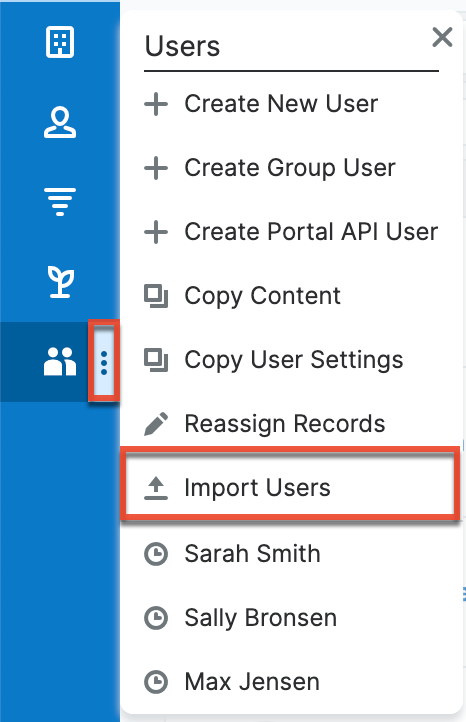
- In Step 1, select the source of the data you are importing. Click "Next".
- In Step 2, select the import file and choose "Create new records only". Click "Next".
- In Step 3, confirm the import file properties. Click "Next".
- In Step 4, confirm the field mappings for the import. Click "Next".
- In Step 5, configure any fields you would like to use for duplicate checking.
- In Step 6, view the import results.
- The Created Records tab will show all of the new user records.
- The Duplicates tab will show any records in the file that were detected as a duplicate and thus not imported from the duplicate check in Step 5 of the Import Wizard.
- The Errors tab will show records that were not imported due to errors detected during import.
Viewing Users
There are various options available for viewing user records in Sugar including via Users recently viewed, Users list view, Users detail view, dashlets, and reports.
Note: If your instance uses SugarIdentity, then you can also view the user's basic and employment-related information in SugarIdentity.
Viewing via Recently Viewed
As you work, Sugar will keep track of which users you have recently viewed. Click the Actions menu in the Users module tab to see a list of your most recently viewed users, and click each name to open the user in detail view.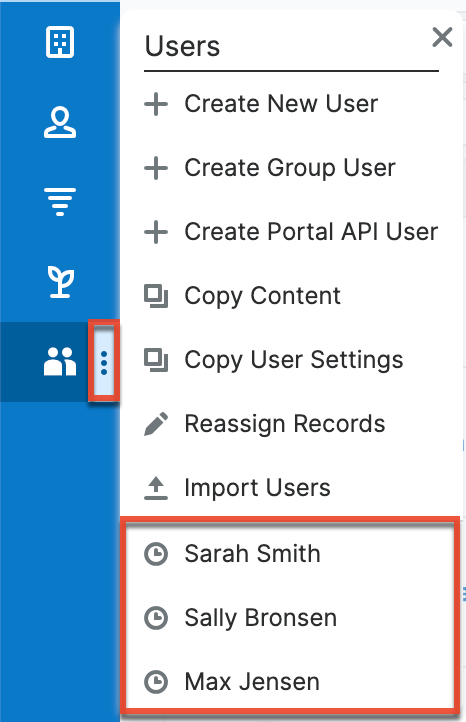
Viewing via List View
The Users list view displays all user records meeting the current search criteria. To access the list view, navigate to Admin > User Management. While the list view shows key user fields, you can click the user's name to open the record in detail view. For more information on viewing users via list view, please refer to the Users List View section of this page.
Viewing via Detail View
The Users detail view displays thorough user information including all user fields followed by subpanels of the user's related records belonging to various modules. The detail view also provides the Access tab, which allows Teams and Roles to be related to the user. Any admin user can click a user record's link from anywhere in the application, including from the Users list view to access the user's detail view. For more information on viewing the user's detail view, please refer to the Users Detail View section of this page.
Viewing via Dashlets
The Home page displays a collection of Sugar dashlets that allow users to get a quick view of various records, activities, reports, etc. Clicking a user's name from any dashlet will open the user in detail view and administrators can make changes to the user's profile as necessary. For more information on using dashlets, please refer to the Dashboards and Dashlets documentation.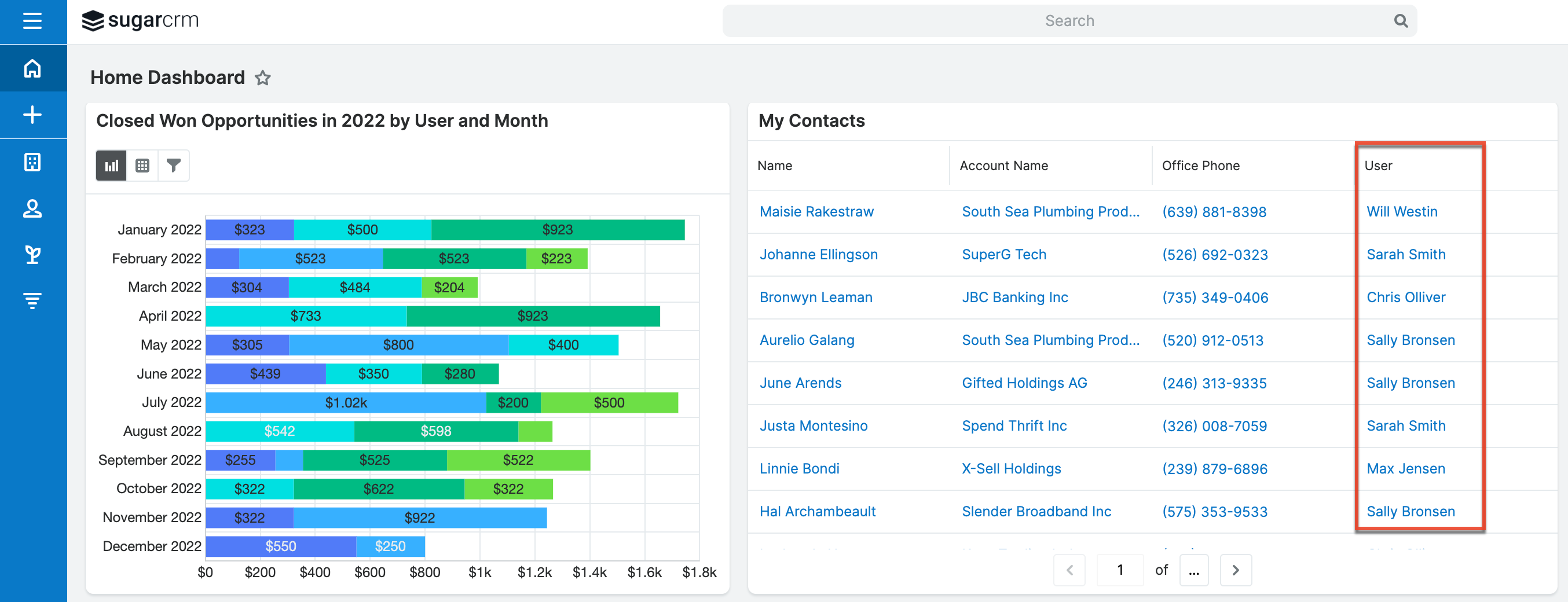
Viewing via Reports
Administrators have the option to build, run, and manage reports to gather key data from records within Sugar. When building a report, you may either create a report based on the Users module or add links to the Users module in a report based on a module related to Users. Once the report is run, you can view the user record's detail view simply by clicking the user's name in the report results. Please note that you can only access user detail views via the Rows and Columns and Summation with Details-type reports as Summation and Matrix-type reports do not include hyperlinks in their display columns. For more information on using reports, please refer to the Reports documentation.
Impersonating Users
If your instance uses SugarIdentity, you have the ability to log in as other users in your organization using the "Impersonate (Log in as)" option in SugarIdentity. When impersonating a user in Sugar, you will be able to access and view the same modules and settings as the user's actual account without having to obtain their login credentials. For more information on impersonating a user, refer to the SugarIdentity Guide.
Searching Users
The Users module's list view includes Basic and Advanced Search functionality to help you locate users easily and effectively. Once the search is performed, the relevant search results will be displayed in the Users list view below. Please note that Sugar automatically appends the wildcard character (%) to the end of your search phrase. This allows the system to pull up all records that include the keyword entered in the search. If you would like to broaden the search, you can use the "Wildcard" (%) at the beginning of your text as well (e.g., %manager). This will pull up any record that has the word "manager" in the name, regardless of how it starts or ends (e.g., "Department Manager", "Product Manager" or "Project Manager").
For more information on using the various search methods as well as how wildcards are used, please refer to the Search documentation.
Basic Search
Basic search offers only Full Name as a searchable field. From the Basic search panel, you can click "Advanced Search" to access additional search functionality.
The buttons available in the Basic Search panel are also available in Advanced Search.
- Search: Click the Search button or press your Return/Enter key to perform the search.
- Clear: Click the Clear button to clear all criteria from the searchable fields.
When you run a search, Sugar will return records matching the criteria you typed in the Full Name search box. Once the search is complete, the relevant results will populate in the list view below the search panel. To see all user records, simply click "Clear" and then "Search" to perform a blank search with no filters.
Administrators can also configure what fields appear on the Users Basic Search via Admin > Studio. For more information on editing the Basic Search layout, please refer to the Studio documentation.
Advanced Search
Advanced Search offers a more in-depth search experience than Basic Search including additional fields, layout options, and saved search capability. From the Advanced search panel, you can click "Basic Search" for simplified searching.
The buttons, checkboxes, and dropdowns available in Advanced Search have the following functions:
- Search: Click the Search button or press your Return/Enter key to perform the search.
- Clear: Click the Clear button to clear all criteria from the searchable fields.
- Layout Options: Use the expandable Layout Options section to configure your list view. For more information, please refer to the Layout Options section of the Search documentation.
- Saved Searches: Save, recall, update, and delete searches that you use often. For more information, please refer to the Saved Search section of the Saved Search documentation.
When you run a search, Sugar will return records matching all (as opposed to any) of the fields and checkboxes for which you have given values. For example, if you select "Is Administrator" as "Yes" and enter in a "First Name" to search, Sugar will only return the user records that have a matching first name and are admins. Once the search completes, the relevant results will populate in the list view below the search panel. To see all user records, simply click "Clear" and then "Search" to perform a blank search with no filters.
Administrators can configure what fields appear on the Users Advanced Search via Admin > Studio. For more information on editing the Advanced Search layout, please refer to the Studio documentation.
Users List View
The Users list view displays all user records meeting the current search criteria. You can view the basic details of each user within the columns of fields.
You have the option to change what fields are displayed in list view by configuring your layout options available in Users Advanced Search. For more information on configuring your list view, please refer to the Layout Options section of the Search documentation. You can also change what fields are visible in the list view via Studio. For more information on editing list view layouts, please refer to the Studio documentation.
Checkbox Selection
You can perform actions on user records directly from the list view by first selecting the desired records. To select individual user records on the Users list view, mark the checkbox on the left of each row. To select or de-select multiple user records on the list view, use the options in the checkbox dropdown menu.
- Select This Page: Selects all records shown on the current page of user results.
- Select All: Selects all records in the current search results including all pages of user results.
- Deselect All: De-selects all records that are currently selected.
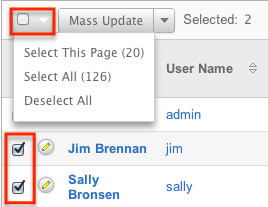
Actions Menu
The Actions menu to the right of the checkbox dropdown allows you to perform various actions on the currently selected records.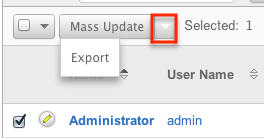
The options in the Actions menu allow you to perform the following operations:
| Menu Item | Description |
| Mass Update | Mass update one or more users at a time. Note: For instances that use SugarIdentity, the administrator will need to access SugarIdentity to mass update the Status and User Type fields. |
| Export | Export one or more users to a CSV file. |
Pagination
List view displays the current search results broken into pages that you can scroll through rather than potentially displaying thousands of rows at once. To the right just below the search panel you can see which records of the total results set are currently being displayed. The two single-arrow next and previous buttons can be used to scroll through the records page-by-page. The two double-arrow first and last page buttons allow you to skip to the beginning or the end of your current results.
By default, Sugar displays 20 records per list view page, but administrators can change the number of records displayed via Admin > System Settings. For more information on changing the number of displayed records, please refer to the System documentation.
Column Sorting
List view provides the ability to sort all of the current search results by a field column in either ascending or descending order. To sort by a field or switch the sort direction, click the column header noting that the fields which allow sorting will have a pair of arrows in the column header. The list view may be sorted by only one column at a time. You can also set a default order-by column using the layout options in Advanced Search to specify which field to automatically sort results by in the list view. For more information on setting a default column sort, please refer to the Layout Options section of the Search documentation.
Users Detail View
The Users detail view displays thorough user information including all user fields which are grouped by default into the User Profile, Advanced, and Access panels. You can also view information from records related to the Users module as subpanels below the detail view. For more detailed information about adding relationships, please refer to the Studio documentation. The detail view can be reached by clicking a user record's link from anywhere in the application including from the Users list view.
Note: If your instance uses SugarIdentity, then you can also view the user's basic and employment-related information in SugarIdentity.
Administrators have the ability to change what fields are visible in the detail view by configuring the field groupings via Admin > Studio. For more information on editing detail view layouts, please refer to the Studio documentation.
Actions Menu
The Actions menu on the top left of each user's detail view allows you to perform various actions on the current record. Please note that administrators in Sugar can change the action items to be displayed as separate buttons instead of a dropdown menu via Admin > System Settings. For more information on how to configure the actions menu, please refer to the System documentation.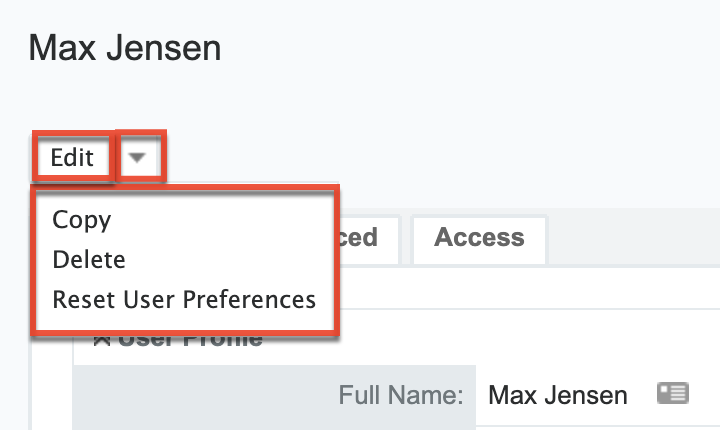
Note: The Copy and Delete options are not available for instances that use SugarIdentity.
The options in the Actions menu allow you to perform the following operations:
| Menu Item | Description |
| Edit | Edit this user. Note: For instances that use SugarIdentity, certain user fields (e.g., First Name, Last Name, Title, Work Phone) can only be edited in SugarIdentity. |
| Copy | Duplicate this user. Note: The Copy option is not available for instances that are SugarIdentity-enabled. |
| Delete | Delete this user. Note: The Delete option is not available for instances that are SugarIdentity-enabled. Administrators can access SugarIdentity to delete a user from Sugar. |
| Reset User Preferences | Revert all user preferences back to system-wide settings. |
Tabs
The detail view for a user is broken up into multiple tabs to better organize the different fields available in the Users module. Some of the available tabs in the user's profile are "User Profile", "Advanced", and "Access". A Downloads tab is also available when viewing your own profile. For more information on viewing your personal user profile, please review the User Preferences documentation.
User Profile
The User Profile tab displays information specific to the user such as the user's name, user type, employment status, contact information, etc. Administrators have the ability to configure the User Profile layout via Admin > Studio. For more information on editing the user's profile in the Users module, please refer to the Editing Via Detail View section of this page.
Note: For instances that use SugarIdentity, certain fields (e.g., First Name, Last Name, Title, Work Phone) in the user's profile are read-only and can only be edited in SugarIdentity.
Advanced
The Advanced tab shows information specific to the user's preferences in Sugar. Information such as the user settings, locale settings, PDF settings, etc. can be easily viewed under this tab. Please note that the layout of this tab cannot be edited in Studio. However, you can edit the information under the tab by clicking the Edit button on the user's detail view. For more information on editing the user's profile, please refer to the Editing Via Detail View section of this page.
Access
The Access tab summarizes the user's Team and Role settings so that it can easily be viewed in one place. The Access table, Roles subpanel, and My Teams subpanel will appear under the tab.
- Access Table: The Access table summarizes the set of permissions assigned to the user and allows you to view the type of access they have along with the actions (e.g., View, Edit, Delete, etc.) they can perform in Sugar. This table is very similar to what appears in Admin > Role Management, but this table is not editable in the Users module.
Note: Users with more than one role assigned will have the more restrictive role setting prevail on the access table. For example, if one role allows the user to delete records in the Contacts module, but the other role does not allow record deletion, the user will not be able to delete records in the Contacts module.
The table will list the modules in rows on the far left with column headers representing the type of action (e.g., Delete, Edit, Export, etc.) users can perform in each module. For more information on role settings, please refer to the Roles documentation.
- Roles Subpanel: The Roles subpanel will list all of the roles assigned to the user along with the description of each role. Roles work in conjunction with teams to form a robust security model for non-admin users in Sugar. Roles control three different layers of access for users within Sugar: module, field, and action-level access. System administrators can easily assign roles to the user as well as remove roles via the Roles subpanel.
- Teams Subpanel: The Teams subpanel will list all of the teams assigned to the user along with the description of each team. The defined permissions determine what records a user is and is not able to access. Teams are used in conjunction with roles to form a robust security model for non-admin users in Sugar. System administrators can easily assign teams to the user as well as remove teams via the My Teams subpanel. For more information on team settings, please refer to the Teams documentation.
Subpanels
Subpanels can be added to the Users module by creating relationships via Admin > Studio. All available subpanels will appear at the bottom of the user's detail view. For more information on adding relationships, please refer to the Relationships section of the Studio documentation.
The User Holidays, Shifts, and Shift Exceptions subpanels are available for the Users module out of the box. The User Holidays subpanel allows administrators to select specific days that the user will not be working, which is used when calculating project timelines in the Projects module and user availability for record assignment in SugarBPM. Holidays can be added using the Create button and inputting a date and description of the holiday.
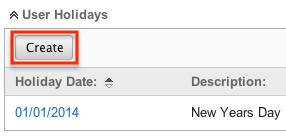
The Shifts and Shifts Exceptions subpanels show the shifts and shift exceptions to which the user is related. This allows you to view the shifts and the exceptions to these shifts that a user has so that you can understand their work schedule and their availability to be round-robin assigned records in SugarBPM. To update an employee's work schedule, click the relevant shift or shift exception to open its record view and add or remove the user in the Users subpanel. See the Shifts and the SugarBPM documentation for more details.
Editing Users
The user's profile can be easily edited by the user or the administrator by clicking the Edit button on the user's detail view. In addition, changes to the user's profile can be made via the Users list view as well by clicking the Pencil icon to the left of the user's name. Editing the user's profile from the detail view and list view opens the full edit view layout which includes all of the relevant fields that can be updated as necessary.
Note: If your instance uses SugarIdentity, then you will need to access SugarIdentity to update certain user fields. 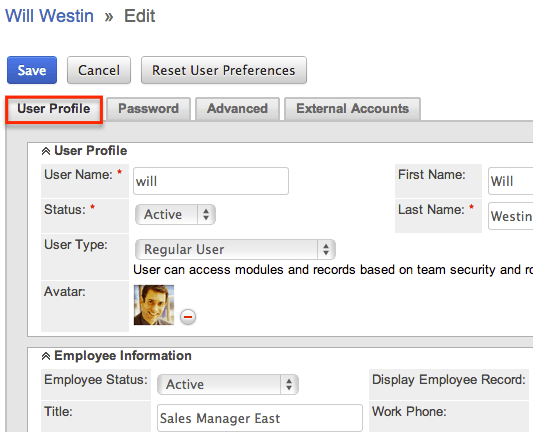
Editing via Detail View
You can edit users by clicking the Edit button on the upper left of the user's detail view. Once the edit view layout is open, update the necessary fields, then click "Save" to preserve the changes made. For more information on the detail view, please refer to the Users Detail View section of this page.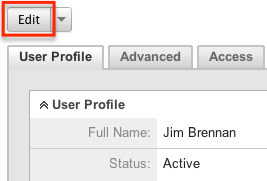
External Accounts
When viewing the edit view of a user, the External Accounts tab appears to the right of the Advanced tab. The External Accounts functionality allows you to connect external applications to Sugar, such as GoToMeeting, Google, and WebEx. To create an external account record, follow the following steps:
- Navigate to the detail view of the user to whom you would like to add the account.
- Click on the External Accounts tab then click "Create".
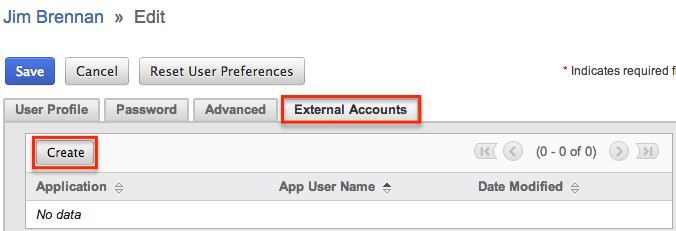
- Select the application you will be connecting to from the Application dropdown field. The fields available to complete will vary depending on the application (GoToMeeting, Google, WebEx) selected. If no fields are present, click "Connect" and a pop-up window will open for you to grant permission or input your credentials, depending on the application. Your pop-up blocker must be disabled for the pop-up to appear. Please note that additional external applications will appear on the list if they are enabled via Admin > Connectors.
- Enter the necessary information for the external application and click "Connect".

Should you wish to prevent users from creating external accounts, you can remove the Create button for users in the External Accounts tab of their profiles by disabling the External Accounts module via a role assigned to those users. Please note the "Access Type" setting will not affect this module. Furthermore, editing or deleting the external account can be done by clicking the account's name on the External Account list view. This brings you back to the edit view with the necessary options and available fields.
The out-of-the-box connectors perform the following functions:
- DocuSign: The DocuSign connector allows you to send documents to DocuSign for electronic signature from within Sugar.
- Dropbox: The Dropbox connector allows you to access your Dropbox via the Cloud Drive dashlet on dashboards throughout Sugar.
- GoToMeeting: The GoToMeeting connector allows you to create meetings in Sugar that are tied to your GoToMeeting account and will show as such on your GoToMeeting account. This allows the user to, after creating the Sugar meeting record, start the GoToMeeting directly from within Sugar's Meetings module.
- Google: The Google connector allows you to create documents within Sugar that, instead of uploading a file to the server hosting Sugar, allows the user to link to an existing Google document from Google Drive or to upload a file to that account. When clicking on a document name in the Documents module or any Documents subpanels, the user will be brought to Google Drive instead of the download being initiated. The Google connector also allows you to use access your Google Drive via the Cloud Drive dashlet on dashboards throughout Sugar.
- Microsoft: The Microsoft connector allows you to access your Microsoft OneDrive via the Cloud Drive dashlet on dashboards throughout Sugar.
- WebEx: The WebEx connector allows you to create meetings in Sugar that are tied to your WebEx account and will show as such on your WebEx account. This allows the user to, after creating the Sugar meeting record, start the WebEx meeting directly from within Sugar's Meetings module.
Editing via List View
You can edit users via the list view by clicking the Pencil icon to the left of each user's name. The full edit view layout will open allowing you to make any changes to the user's profile as necessary. Once the user's profile has been updated, click "Save" to preserve the changes. For more information on the list view, please refer to the Users List View section of this page.
Editing via Import
You can also update existing user records via import using a CSV file. To update existing records, simply select the "Import Users" option under the Users module tab. Please note that the import process will vary between instances that use SugarIdentity and instances that do not use SugarIdentity. For instances that do not use SugarIdentity, refer to the Import documentation for more information on updating existing records via import. For instances that use SugarIdentity, refer to the Importing Updates to Existing User Records section of this page for more information.
Deactivating Users
When a user is no longer a member of your organization, it is best practice to deactivate them instead of deleting them. This ensures that the user will no longer be able to log in to Sugar, but any historical information tied to the user will still be available. While deactivating user records will not update any related records, the Reassign Records tool will be presented and can be used to reassign all of the user's records. If needed, you can filter list views to show records that are assigned to or created/modified by inactive users by filtering the user list on the Status field.
Note: Users that have been deactivated do not count towards your licensed user count.
Note: If your instance uses SugarIdentity, you will need to access SugarIdentity to deactivate a user from Sugar.
Use the following steps to deactivate a user and reassign their records:
- Navigate to Admin > User Management and click the user you wish to deactivate.
- Edit the user record and change the Status field to "Inactive". Click "Save".
- A pop-up message will display asking if you would like to reassign all of the user's records. Click "Yes" if you wish to proceed.
-
You will then be presented with the Reassign Records tool. Follow the steps on this page to complete the deactivation. For more information, please review the Reassigning Records section.
- Once the reassignment is complete, the user will be deactivated and no longer able to log in to Sugar.
Please note that you can also filter list views to show records that are assigned to inactive users by filtering the user list on the Status field and then mass updating the records to be assigned to an active user.
Deleting Users
If a user record is invalid or should no longer appear in your organization's Sugar instance, it may be deleted from the Users detail view. Please note that deleting user records will not delete any related records and will only prevent the user from being selected (e.g., Assigned to). When a user is no longer a member of your organization, it is best to deactivate them by changing the Status field to "Inactive" instead of deleting them. This way, any historical information tied to the user will still be available, but the user will no longer be able to log in to Sugar.
Note: If your instance uses SugarIdentity, you will need to access SugarIdentity to delete a user from Sugar.
Use the following steps to delete a user and reassign their records:
- Navigate to Admin > User Management and click the user you wish to delete.
- Select "Delete" from the Actions Menu.
- A pop-up message will display asking for confirmation. Click "OK" to proceed.
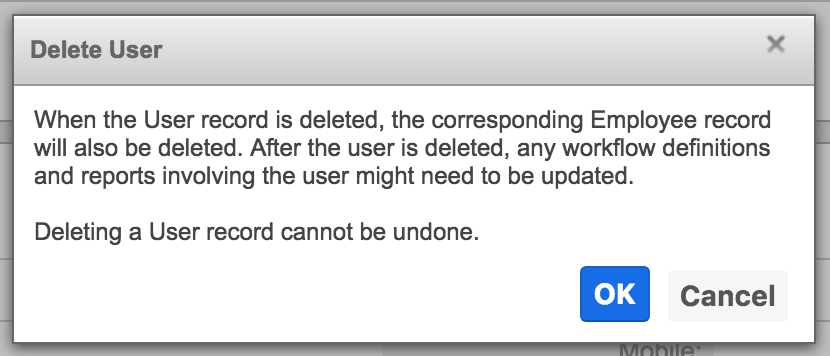
- You will then be presented with the Reassign Records tool. Follow the steps on this page to complete the deletion. For more information, please review the Reassigning Records section.
- Once your reassignment is complete, the user will be deleted, and you can freely navigate around Sugar.
Exporting Users
Sugar's Export option allows users to download all fields for the selected users to their computers as a .CSV (comma-separated values) file. This may be useful when needing to use User data with other software such as Microsoft Excel or to update existing records by exporting, making changes, and then importing the altered users back into Sugar. For more information on updating existing records via import, refer to the Import documentation.
Users may be exported from the Users list view by selecting "Export" from the Actions menu. User data can also be exported via the Reports module by creating or accessing reports containing specifically chosen fields for users and their related record(s). For more information on exporting records in Sugar, please refer to the Export documentation.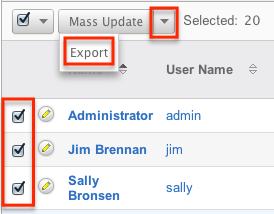
Due to PHP memory limitations on the server, there may be occasions when the application times out while exporting a large number of user records. If you encounter an error when performing this action, we recommend selecting the records in smaller batches.
Importing Updates to Existing User Records
In addition to importing new user records via Sugar's Import Wizard, you can also import updates to existing user records in Sugar using a CSV file. Please note that the import process will vary between instances that use SugarIdentity and instances that do not use SugarIdentity.
For instances that do not use SugarIdentity, refer to the Import documentation for more information on updating existing records via import.
For instances that use SugarIdentity, use the following steps to update existing user records via import:
Note: Fields that are only editable in SugarIdentity cannot be updated via import in Sugar.
- Click the three-dots menu in the Users module tab to access the Actions menu and select "Import Users".

- In Step 1, select the import file and click "Next".
Note: To create new user records via import, click the "SugarCloud Settings" link to perform the import in SugarIdentity.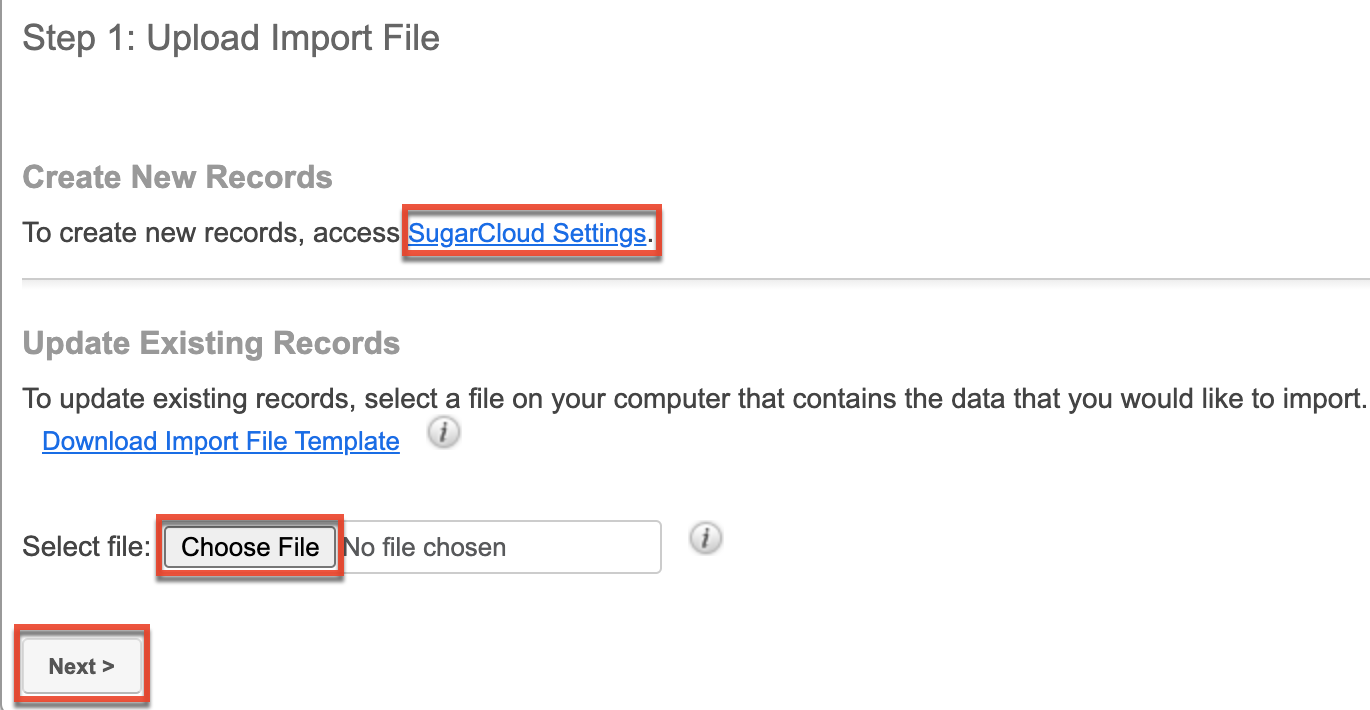
- In Step 2, confirm the import file properties. Click "Next".
Note: Configuring the import file properties (e.g., Name Display Format) for fields (e.g., First Name, Last Name) that are not editable in Sugar will not apply to the data in the import file. - In Step 3, confirm the field mappings for the import then click "Import Now".
Note: Fields that are only editable in SugarIdentity will not be available to map. - In Step 4, view the import results. The Errors tab will show records that were not imported due to errors detected during import.
Note: If the import file includes any changes to fields that are only editable in SugarIdentity, it will not get updated in the record.
Mass Updating Users
Mass Updating allows users to make the same change to multiple user records at once from the Users list view. Users with administrator or developer-level access can control which fields are available to change during mass update via Admin > Studio. Currently, only fields with the data type of date, datetime, dropdown, multiselect, and radio may be altered during a mass update. Due to PHP memory limitations on the server, there may be occasions when the application times out while updating a large number of user records. If you encounter an error when performing this action, we recommend selecting the records in smaller batches. For more information on configuring mass update, please refer to the Studio documentation in the Administration Guide.
Note: For instances that use SugarIdentity, the administrator will need to access SugarIdentity to mass update the Status and User Type fields.
Use the following steps to mass update user records from the list view:
- Navigate to the Users list view via Admin > User Management.
- Use the list view's Basic or Advanced Search to identify users you wish to modify.
- Select the desired users individually or using the checkbox dropdown's options.
- Choose "Mass Update" from the Actions menu.
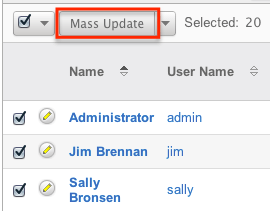
- Scroll to the Mass Update panel and set values for the fields you wish to alter.
- Click "Update" to save the changes to all of the currently selected user records.
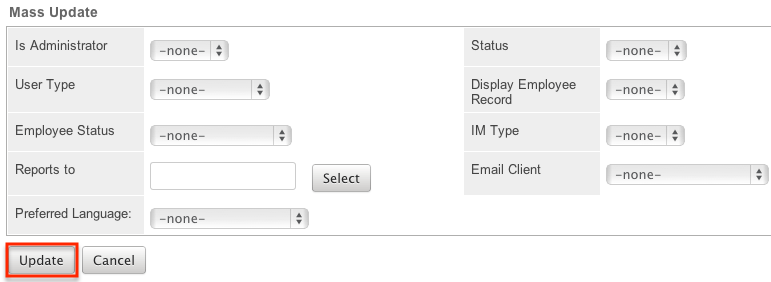
Resetting User Preferences
As users make changes while navigating around Sugar, their preferences are stored in the Sugar database. This includes preferences such as sort orders on list view, previous searches on both basic and advanced searches, and settings in the Advanced tab of the user profile. Users can reset their preferences back to the default out-of-the-box settings, which will revert the user's changes made in Sugar. Please note that this action cannot be undone. If the user is currently logged in, the changes will not take effect until the user is logged out and then back in.
Note: Resetting a user's preferences is the only way to allow a user access to Sugar if they have been locked out using the Login Lockout feature in Password Management.
Use the following steps to reset a user's preferences:
- Navigate to the user's detail view via Admin > User Management and select the user (e.g., Jim Brennan) from the list view.
- Select "Reset User Preferences" from the Actions menu.
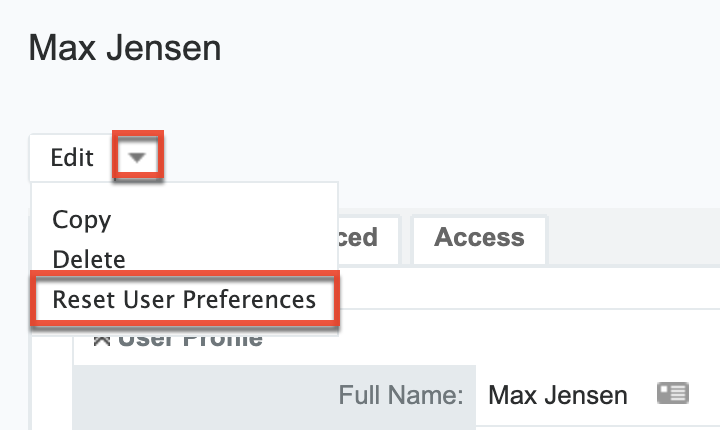
- A pop-up box will appear confirming the reset. Click "OK" to proceed.
Resetting User Passwords
Administrators have the option to manually set or reset users' passwords as necessary. Please choose one of the following methods based on whether your instance uses SugarIdentity or not:
| SugarIdentity disabled | SugarIdentity enabled |
|
1. Navigate to the user's detail view via Admin > User Management. 2. Click the Edit button on the upper left of the detail view. 3. On the Password tab, enter the new password. 4. Click "Save" to confirm your change. |
Administrators can click the lock icon in the Users list view of SugarIdentity to send password reset emails to users. For more information, refer to the SugarIdentity Guide. |
Note: The user needs to log out and then back in for the change to take effect.
Copying User Preferences, Dashboards, and Filters to Other Users
Administrators can reduce the learning curve for new users by broadcasting the setup of an existing user to individual users or users on a given team or role via the Copy Content (preferences, dashboards, and filters) and Copy User Settings (locale settings) options in the Users menu.
Copying Content
Administrators can save time setting up users with the Copy Content tool, which copies select user preferences, dashboards, and filters from one user to other users, teams, or roles. Content can be copied to individual or multiple users, teams, or roles. Copying user preferences will overwrite the recipient users' existing preferences.
To copy content such as dashboards, filters, and user preferences from one user to other users, follow these steps:
- Navigate to the Users module via Admin > User Management.
- Click the three-dots menu in the Users module tab to open the Actions menu and select "Copy Content".
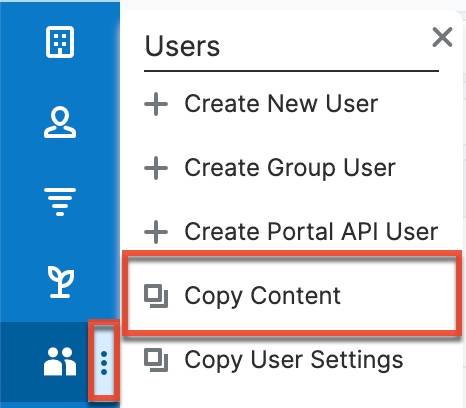
- From the "Copy item" dropdown, select the type of content to be copied. Refer to the Content Types section for descriptions of each type of content.
- In the "From User" list, select the name of the user from which to copy the identified content.
- Click into any of the "To" fields to open a Search and Select drawer to locate the users, teams, or roles, to which the content should be copied.
- Click the Copy button at the top right-hand corner of the page. A confirmation message displays when the copy has been completed.
Note: When content is copied to user accounts, the users are not notified of the change.
Content Types
The following lists contain the types of content that can be copied from a user.
User Preferences
- Default Teams: The teams set as default teams in the source user's profile user settings.
- Favorite Reports: The reports identified as favorites.
- Navigation Bar Module Selection: The modules and the order in which they are displayed in the navigation bar as defined in the source user's layout options.
- Notify on Assignment: Copies the "Email on Assignment" option as defined in the source user's profile user settings.
- Reminder Options: Copies the reminders as defined in the source user's profile user settings.
- Scheduled Reporting: Copies the source user's scheduled report settings.
- Sugar Email Client: Copies the email client as defined in the source user's profile email settings.
Dashboards
- From Modules: Select this option to copy all of the source user's dashboards from a designated module.
- Existing Dashboards: Select this option to locate specific dashboards to copy from the source user.
Note: When a dashboard is selected as a favorite by the source user, it will be identified as a favorite in all user accounts to which the dashboard is copied.
Filters
- From Modules: Select this option to copy all of the source user's filters from a designated module.
- Existing Filters: Select this option to locate specific filters to copy from the source user.
Copying User Settings
The Copy User Settings tool allows administrators to easily set the locale settings for individual users or users in a given team or role.
To copy user locale settings to other users, follow these steps:
- Navigate to the Users module via Admin > User Management.
- Click the three-dots menu in the Users module tab to open the Actions menu and select "Copy User Settings".
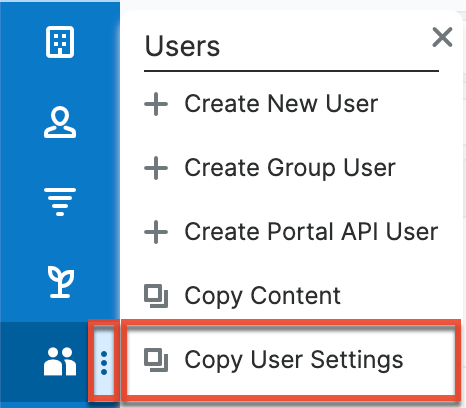
- Select the checkbox next to the settings to be copied. Refer to the Getting Started documentation in the Sugar Application Guide for more information on these settings.
- Click into any of the "To" fields to open a Search and Select drawer to locate the users, teams, or roles to whom the settings should be applied.
- Click the Copy button at the top right-hand corner of the page. A confirmation message displays when the assignment has been completed.
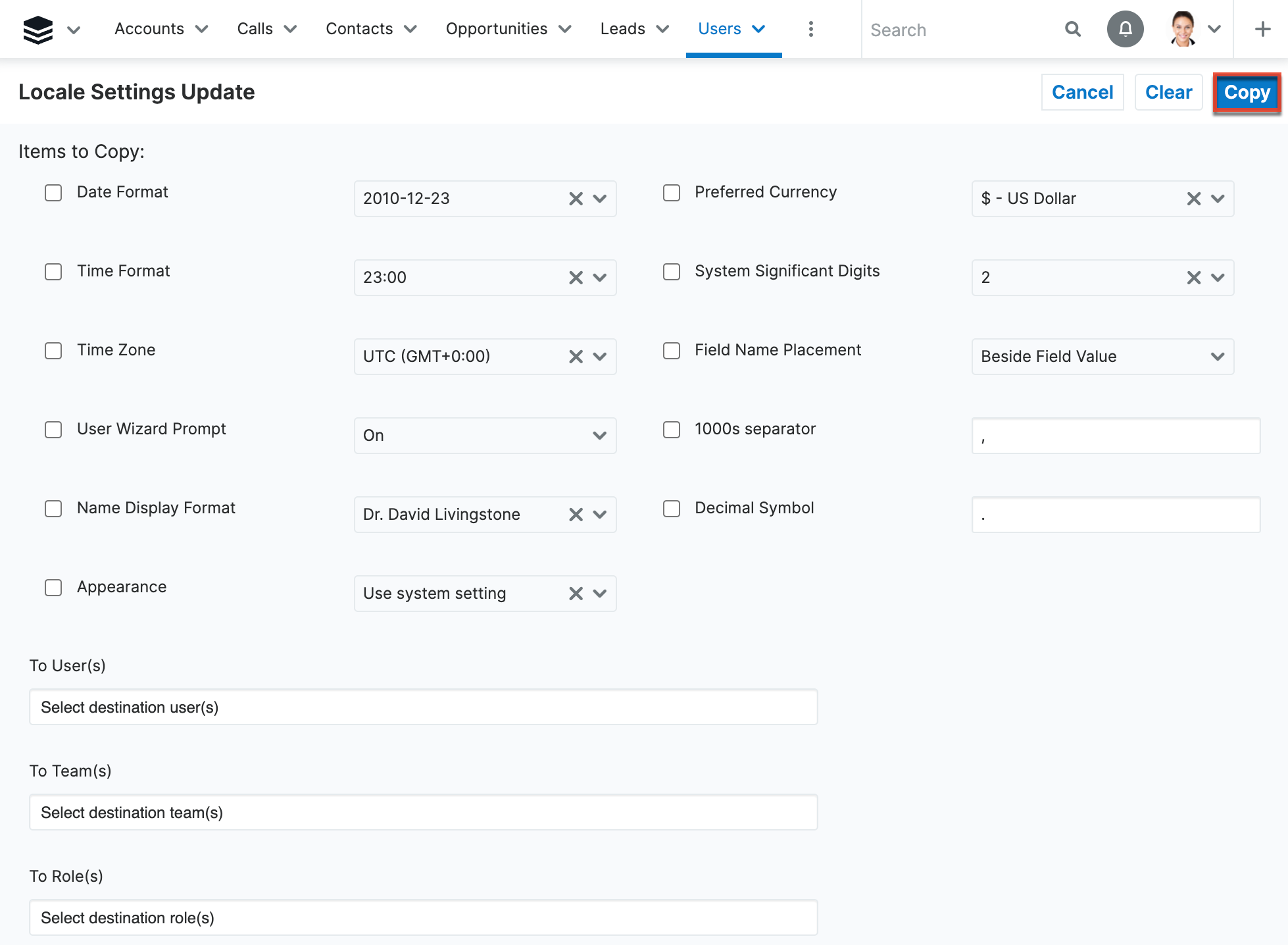
Reassigning Records
Reassign Records is a tool available in the Users module for administrators to change the Assigned To and Team fields for a specific user's records. This is best used when a user is changing departments, teams, or roles within the organization, or if the user is no longer an employee or using Sugar. The Reassign Records tool is automatically presented when deleting or deactivating a user. Please note that reassigning records cannot be undone in Sugar.
Note: You can locate records assigned to Inactive users by filtering the module's list view.
Use the following steps to reassign records:
- Navigate to the Users module via Admin > User Management.
- Click the three-dots menu in the Users module tab to open the Actions menu and select "Reassign Records".
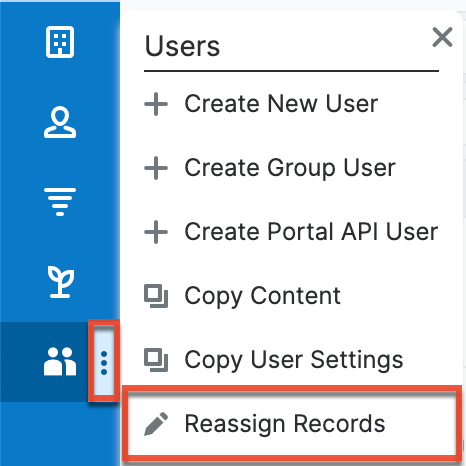
The Reassigning Records tool can also be accessed during the process of deleting or deactivating a user, where it is used to reassign a user's records before deleting or deactivating them. - Select the user to whom the records are already assigned in the From User field.
- Select the user to whom the records will be assigned to in the To User field.
Note: You can select the same user in both fields if you are just changing the team for all of the user's records. - Select which team(s) the records will be assigned to in the Set Teams to field.
- Select the module(s) you wish to include in the record reassignment. Multiple modules can be selected by holding down the Control key when using a PC or the Command key when using a Mac.
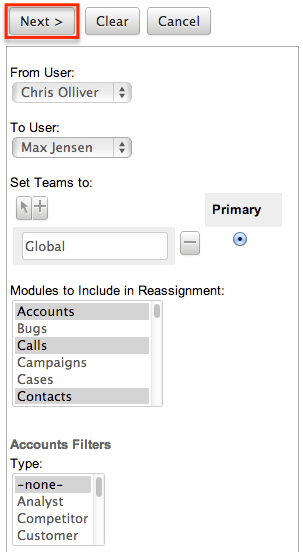
- Selecting certain modules will display specific filters (e.g., Type) which can be applied to the module. Use these filters if you do not want to include all records assigned to the user. The list of modules and their filter fields are as follows:
Module Filter Field Accounts Type Bugs Status Calls Status Cases Priority
StatusDashboards Default Dashboard Opportunities Sales Stage
TypeTasks Status - After selecting any filters, click "Next" to access the reassignment summary.
- If you would like to see a detailed list of the changes that were made, click "Verbose Output". This list will include a link to the changed records and a summary of changes that were made.
- If you would like the changes to show in the Change Log for the changed record, have any relevant workflows fire, or have assignment notifications sent out, please click the Include Workflow/Notifications/Audit checkbox.
Note: This process performs a large set of actions at once and may take a long amount of time to complete.
- Click "Next" to complete the reassignment.
- The final summary page will show how many records were affected and if any errors occurred during the reassignment. Click "Return" to return to the main screen of the Reassigning Records tool.
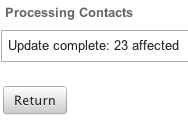
Due to PHP memory limitations on the server, there may be occasions when the application times out while reassigning a large number of user records. If you encounter an error when performing this action, we recommend reassigning records in smaller batches via each module's mass update option.
